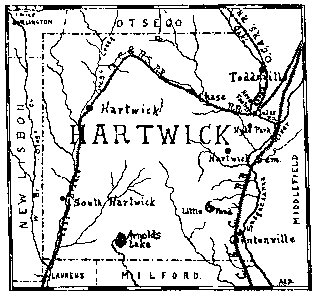
Image and text from Otsego county New York Geographical and Historical
by Edwin F Bacon, Ph B. 1902 Oneonta NY
| Page 33. HARTWICK. Area 25,980 Acres. Population 1,800. Hartwick was formed from Otsego in 1802. Its surface is hilly, the highest summits being 200 to 350 feet above the valleys. It is drained by several small streams that flow into the Susquehanna and the east branch of the Otego creek. The township was named in honor of the Rev. John Christopher Hartwick, who, in 1752, purchased from the Indians for the sum of 100 pounds, a tract of land embracing nearly all of the present township and amounting to 21,500 acres. Mr. Hartwick was a native of the dukedom of Saxe-Gotha in the province of Thuringia in Germany, and had come as a Lutheran missionary to this country. He was for many years a noted preacher throughout the country from New England to Virginia, and it was not until after the Revolution that he settled down upon his purchase and established a colony. Through the agency of Judge William Cooper he let a great part of his land to settlers at an annual rental of one shilling per acre, with the privilege of purchasing at fourteen shillings per acre. HARTWICK SEMINARY. In his will Mr. Hartwick left his whole fortune for the establishment of the Seminary that bears his name. The school was opened on the 15th of December, 181, with the Rev. Dr. Ernest Lewis Hazelius as principal. It now has three departments--Regents, Collegiat, and Theological. The builngs have recently been remodeled and enlarged. The institution is located four miles south of Cooperstown, on the Cooperstown and Charlotte Valley railroad. Cnspicuous among the natives of Hartwick was William H. Bissell who was born in this town in 1811, but early removed with his parents to Milford where he grew to manhood. He prepared himself for the medical profession, but abandoned it for the law. In 1837 he removed to Illinois, from which state he served as a colonel in the Mexican war. He also represented his district in congress from 1849 to 1855. In 1856 he was elected governor of the state, was re-elected and died at Springfield, Ill., in 1860, while serving his second term. Among the early settlers were the brothers John and Nathan Davidson, William and Nathan Field, Jerry Potter, Jedediah Ashcraft, Joseph Marsh, Nicholas and Rufus Steere, Amos and Joseph Winsor, Benjamin and Nicholas Camp, John and Phillip Wells, Hopkins Burlingame, Isaac Bissell, Deacon Ziba Newland, Amasa Peters, Uriah Luce, Stephen Ingalls, David and Josiah Maples, Daniel Murdock and Col. Henry Wheeler. The first supervisor was Phillip Wells, and the first town clerk was Rufus Steere who built the cotton factory at Toddsville. VILLAGES: There are five villages in this township, viz.: Hartwick (population 605), Hartwick Seminary (population 124), South Hartwick (population 63), Toddsville (population 302), and Hyde Park (population 150). Chase is a rural post office. Clintonville, formerly a cotton cloth manufacturing village, has now only an electric lighting plant, from which Cooperstown is supplied, post office at Milford. On the Fourth of July, 1902, Hartwick village celebrated its 100th anniversary. SCHOOLS: Number of districts 16; number of teachers 17; number of children of school age 342. The Hartwick Union Free school has a commodious building, newly furnished and provided with a good library, natural history and chemical apparatus, and other appliances for teaching. It is a school of four grades and confers Regents' diplomas on its academic graduates. CHURCHES: There are eight churches in this township, viz.: At Hartwick, Baptist, Christian and Methodist; at Toddsville, Union and Methodist; at Hartwick Seminary, Lutheran; at Hyde Park, Methodist; and a Christian church near Christian Hill in the northern part of the township. NEWSPAPERS: There are two weekly papers, the Hartwick Review and Hartwick Visitor, published at Hartwick village. The Hartwick Seminary Monthl and Eastern Lutheran, the organ of Hartwick Seminary, is edited and published at the Seminary. Transcribed by Karen Flanders Eddy. KARENE1@webtv.net |